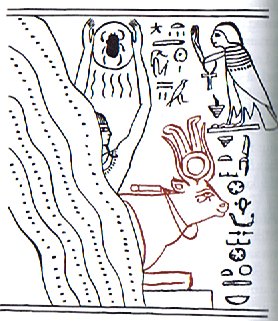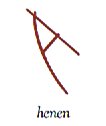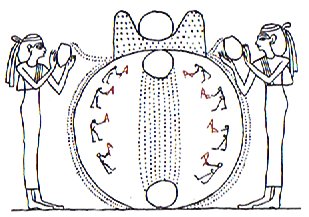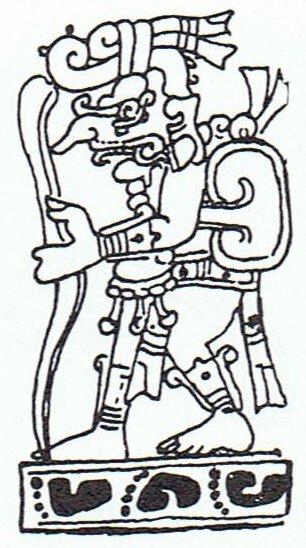222. In the 4th day Ilmarinen broke a Plough (cfr at Ursa Major below) to pieces and then at last the creation of Sampo could begin: And a plough rose from the furnace, // With the ploughshare golden-shining, // Golden share, and frame of copper, // And the handles tipped with silver. And the plough was fair to gaze on, // But of evil disposition; // Ploughing up the village cornfields, // Ploughing up the open meadows, Therefore did smith Ilmarinen // Take no slightest pleasure in it. // And he broke the plough to pieces, // Cast it back into the furnace, Called the winds to work the bellows // To the utmost of their power. // Then the winds arose in fury, // Blew the east wind, blew the west wind, // And the south wind yet more strongly, // And the north winds howled and blustered. Thus they blew one day, a second, // And upon the third day likewise. // Fire was flashing from the windows, // From the doors the sparks were flying // And the dust arose to heaven, // With the clouds the smoke was mingled.
Also in Babylon and in the round Dendera zodiac there was a Plough high up in the north, and the Wolf was standing on it:
... Exactly whom Boötes is supposed to represent in Greek mythology is not clear. According to one version, he was a ploughman who drove the oxen in the constellation Ursa Major using his two dogs Chara and Asterion (in the constellation Canes Venatici). The oxen were tied to the polar axis and so the action of Boötes kept the heavens in constant rotation ... ... Wild Boar (Most of Centaurus). The Wild Boar is sacred to Ningirsu, a local form of Ninurta, who is a god closely associated with farming. Indeed the boar's habit of churning up the earth as it forages for food may ultimately be the historical inspiration for the invention of the plough, which allowed early societies to adopt a sedentary lifestyle ... ... The Plough, (Most of Draco). The Wolf at the seed funnel of the Plough (Head & middle of Draco) ...
High up in the
circumpolar night the distinction
between the heliacal perspective and the
nakshatra - close to the Full Moon -
view disappeared, and there was
'a close embrace' between the Sun
and the Moon.
... They were Ranginui, the
Sky Father, and Papatuanuku,
the Earth Mother, both sealed
together in a close embrace. Crushed
between the weight of their bodies
were their many children, whose
oppression deepened. They yearned to
be free; they fought their parents
and each other to break loose.
Tuumatauenga, virile god of war,
thrust and shouted; Tangaroa
of the oceans whirled and surged;
Tawhirirangimaatea,
Haumiatiketike and
Rongomatane, of wild foods and
cultivated crops, tried their best
but were not successful; and
Ruamoko, god of earthquakes, yet
to be born, struggled in the
confinement of his mother's womb ...
Of them all, Taane Mahuta,
the god of the forests, was the most
determined; he set his sturdy feet
upon his father's chest, and braced
his upper back and shoulders against
the bosom of his mother. He pushed;
and they parted. So the world, as
the Maori understand it, came into
being ...
The Canes
Venatici constellation had its star Cor Caroli (the Heart
of King Charles) as
α and
this was 183 right ascension days away from
the Whip (γ Cassiopeia), but this did not matter
because
they were anyhow quite close together:
... This star, the 12th on
Flamsteed's list of the Hounds,
stands alone, marking Chara's
collar; but was set apart in
1725 by Halley, when Astronomer
Royal, as the distinct figure
Cor Caroli, not Cor Caroli
II as many have it, in honour of
Charles II. This was done at the
suggestion of the court
physician, Sir Charles
Scarborough, who said it had
shone with special brilliancy on
the eve of the king's return to
London on the 29th of May
...
...
With Ulug Beg it was Al Kabd
al Asad, the Liver of the
Lion, - here a technical term
indicating the highest position
of any star within the compass
of a figure reckoned from the
equator ...
ν
Andromedae (11.0),
φ²
Ceti (11.1),
ρ
Phoenicis (11.2),
η
Andromedae
(11.4)
... At the beginning of
44 B.C. - when Ceasar
was still alive - the
Senate decided to raise
statues of him in all
the temples and to
sacrifice to him on his
birthday in the month
Quintilis, which in
honour of him was
renamed July. He was
raised to the status of
a god (among the other
gods of the state) under
the name Jupiter Julius.
Marcus Antonius, who
this year was consul
together with Ceasar,
became high priest and
responsible for the
ceremonies. In the
middle of February, at
the time of the old
feast of Lupercalia
[cfr Lupus =
Wolf], he ran around
naked and whipped the
Roman ladies with thongs
made from goat-skin [februa],
in order to promote
their fertility ...
ξ¹ Centauri (197.1), ξ²
Centauri (197.9) ... Apin means Plough, and I suppose the fields (cfr 1-iku) had to be plowed at the beginning of the agricultural year - not only the fields down on earth but also the fields up in the sky. This hard work should have been facilitated by a pair of water-buffaloes:
Remarkably, in the round reconstruction of the Babylonian zodiac a Plough constellation has been put not where Triangulum (Apin) can be expected but close to the north pole. For some reasons the north pole seems to have been connected with the beginning of the year. But visualizing the sky roof as a kind of Chinese Mill (with a horizontal axle instead of a vertical) makes it easy to understand - also Polaris is close to 02h. Perhaps one Plough was close to the north pole and another (Apin) further down. Maybe this was a sign of the width of the enormous field the Bull of Heaven (Taurus) had to turn over, perhaps the whole sky from the tropic of Cancer and up to the polar circle ... In the C text the vero (spear) at the Whip (and the Heart of King Charles) was evidently designed to visualize a special case, a 'spear' with a softly rounded bottom:
This phenomenon was beginning with Ca13-19 which was drawn exactly as *Ca14-15, and although the month name Vero had been assigned to April the culmination at 21h of the fixed stars rising heliacally in this month should have pointed to their ancient positions earlier, for instance:
... Nevertheless, by virtue of a series of spectacular coincidences, Cook made a near-perfect ritual exit on the night of 3 February [i.e., in day 365 + 31 + 3 = 399]. The timing itself was nearly perfect, since the Makahiki rituals would end 1 February (± 1 day), being the 14th day of the second Hawaiian month [Kau-lua].
At the time when Betelgeuze rose with the Sun at 0h, i.e. 88 right ascension days earlier than at my assumed time frame for rongorongo, glyph number 378 on the C tablet would have corresponded to day 92 (April 2) - 88 = 365 + 4 = 369. Going backwards in the text to the identical vero in Ca13-19 (from where to count, hia) corresponds to moving backwards in time to day 369 - (378 - 362) = 353, i.e. the stars at Ca13-19 would at *Ca14-15 reappear again after having in 16 nights been too close to the rays from the Sun for observation:
There are 348 glyphs on side b of the tablet and by adding those in line Ca14 the number will increase to 29 + 348 = 377 = 13 * 29. ... The ordinary year in the previous Roman calendar consisted of 12 months, for a total of 355 days. In addition, a 27-day intercalary month, the Mensis Intercalaris, was sometimes inserted between February and March. This intercalary month was formed by inserting 22 days after the first 23 or 24 days of February; the last five days of February, which counted down toward the start of March, became the last five days of Intercalaris. The net effect was to add 22 or 23 days to the year, forming an intercalary year of 377 or 378 days ... I.e., 392 (side a) + 348 (side b) = 740 = 13 * 29 + 354 + 9 = 376 (= 392 - 16) + 364 (= 16 + 348):
... The star Mirach is β Andromedae, and it was rising about 1h earlier than the northern tip of the plough Apin (nowadays γ Andromedae):
The plough was an instrument not only to turn Mother Earth over again, to enable her to produce the food without which we all would die, but it could also be a tool for creating fire ... ... In reference to your question, 'How do the natives of Easter Island obtain fire?' I [Mr. Croft] have to answer that they cannot tell. Their forefathers, like the ancient Romans, had their 'vestal' fires, preserved from ancient times; but the 'Vestal Virgins' of Easter Island were gray-headed and gray-bearded old heathen priests. It was a part of their duty, sacredly attended to, to guard the eternal fire, which was neutral, together with its guardians, in all wars. From this sacred fire the whole community - at one time a large one - could obtain that useful 'element' from time to time, as they needed it, for culinary and other purposes. This custom is still kept up by a portion of the community, while another portion rely on the matches of Mr. Dutrou-Bornier for their supply. Another portion of the community have learned from Gambier Islanders (who were sent there by the Catholics, to assist the priests) how to make fire: not by rubbing two sticks together, as you ask in your letter, but by rubbing the point of one stick on the side of the other, until it makes a hot groove and eventually fire - a work generally of from five to ten minutes. In order to illustrate this, I have had a photograph taken for you, showing you the natives in the very act of producing fire, and have also sent you the identical sticks used on that occasion. You will notice that the wood is of a soft and spongy nature. It grows abundantly on these islands, and is a variety known as the Hibiscus tiliaceus, and called by the natives 'Purau' and 'Fau', pronounced 'Purow' and 'Fow', 'ow' being sounded as in the word 'how'. You can, if you wish, obtain large quantities of it, by going on board the vessels carrying oranges from these islands to San Francisco; the orange crates are mostly made of it. And you could also get one of the Tahitian or other islanders, sailors on board of such vessels, to make fire for you by the aid of these sticks, and thus practically or ocularly answer your own question, as they are all experienced in the art ... In Babylonia the constellation was named Apin and it included Alamak (γ Andromedae):
... In the description of the Babylonian zodiac given in the clay tablets known as the MUL.APIN, the constellation now known as Aries was the final station along the ecliptic. It was known as MULLÚ.ḪUN.GÁ, 'The Agrarian Worker'. The MUL.APIN is held to have been compiled in the 12th or 11th century BCE, but it reflects a tradition which takes the Pleiades as marking vernal equinox, which was the case with some precision at the beginning of the Middle Bronze Age (early 3rd millennium BCE). In later Babylonian tradition, the name of the constellation changes to MULUDU.NITÁ 'ram'. The motive for the name change is unknown. John H. Rogers suggests that the 'Agrarian Worker' became the 'Ram' via association with the legendary figure of Dumuzi the Shepherd. Gavin White suggests that the sumerogram LÚ 'man' may have come to be understood as Akkadian lu 'sheep'. Aries only rose to its prominent position as the leading sign of the zodiac in the Neo-Babylonian (7th century BCE) revision of the Babylonian zodiac, as Hamal (α Ari) came to be located close to the point of vernal equinox. In Hellenistic astrology, the constellation of Aries is associated with the golden ram of Greek mythology that rescued Phrixos on orders from Mercury, taking him to the land of Colchis. Phrixos sacrificed the ram to the gods and hung its skin in a temple, where it was known as the Golden Fleece. The Golden Fleece was then stolen by Jason and the Argonauts. The First Point of Aries, the location of the vernal equinox, is named for the constellation. This is because the Sun crossed the celestial equator from south to north in Aries more than two millennia ago. Because of the precession of the equinoxes, the First Point of Aries has since moved into Pisces and will move into Aquarius by around 2600 C.E. The Sun now appears in Aries from late April through mid May ... ... Mul-Apin is a composite text that can be thought of as a general compendium dealing with many diverse aspects of celestial divination.The first sections of tablet 1 list all the mainstream Babylonian constellations along with the deities associated with them. Various other sections give the rising dates for the stars and provide further useful information that helps to locate the constellations in relation to each other and as such it is the single most important resource for reconstructing the overall plan of the Babylonian starmap. Even though the earliest copy so far discovered was only written shortly after 700 BCE, the text was probably composed sometime between 1200 and 1000 BCE. The following lists are derived from Mul.Apin, An Astronomical Compendium in Cuneiform by Hermann Hunger and David Pingree, 1989 ... When Ira had entrusted Makoi the task of naming places on Easter Island Makoi (probably alias Saturn) made a circuit moving clockwise and began not with the 3 islets outside Rano Kau but with Apina Iti, the softly rounded peninsula south of Hanga-Roa. We can find the name on the map of Métraux:
Words in the Polynesian language cannot end with -n and therefore Apina Iti should be understood as 'the Little Apin'. Not far away there was also a place named Apina Nui (the Great Apin). A page from my preliminary Glyph Type Dictionary (at Honu):
The emblem of the 'plough' was probably used for the kilt of Pharaoh inside his 'Palace Chapel', drawn rather similar to the first letter in the Roman alphabet (A):
Furthermore, the plow was in the hands of the Babylonian figure Harrow, designed to be half Bull and half Man. And when Pharaoh emerged from his Palace Chapel he wore the belt of the Hathor cow and the tail of a bull: ... When he reappeared he was clothed as in the Narmer palette, wearing the kilt with Hathor belt and bull's tail attatched ...
The plough (henen) depicted a 'digging stick':
Manuscript E (p. 18) with Barthel's translation:
|
|||||||||||||||||||||||||||||||||||||||||||||||||||||||||||||||||||||||||||||||||||||||||||||||||||||||||||||||||||||||||||||||||||||||||||||||||||||||||||||||||||||||||||||||||||||||||||||||||||||||||||||||||||||||||||||||||||||||||||||||||||||||||||||||||||||||||||||||||||||||||||||||||||||||||||||||||||||||||||||||||||||||||||||||||||||||||||||||||||||||||||||||||||||||||||||||||||||||||||||||||||||||||||||||||||||||||||||||||||||||||||||||||||


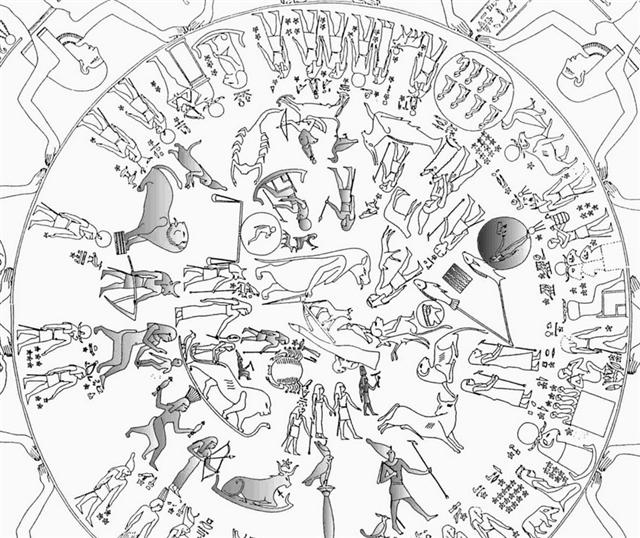

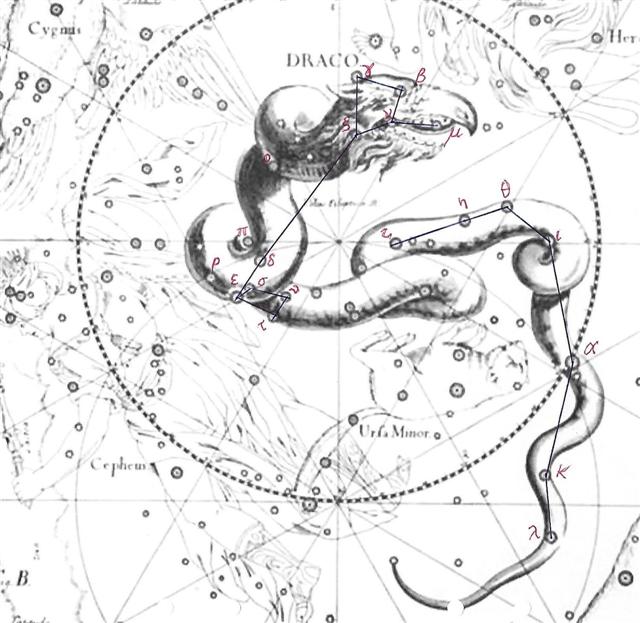

















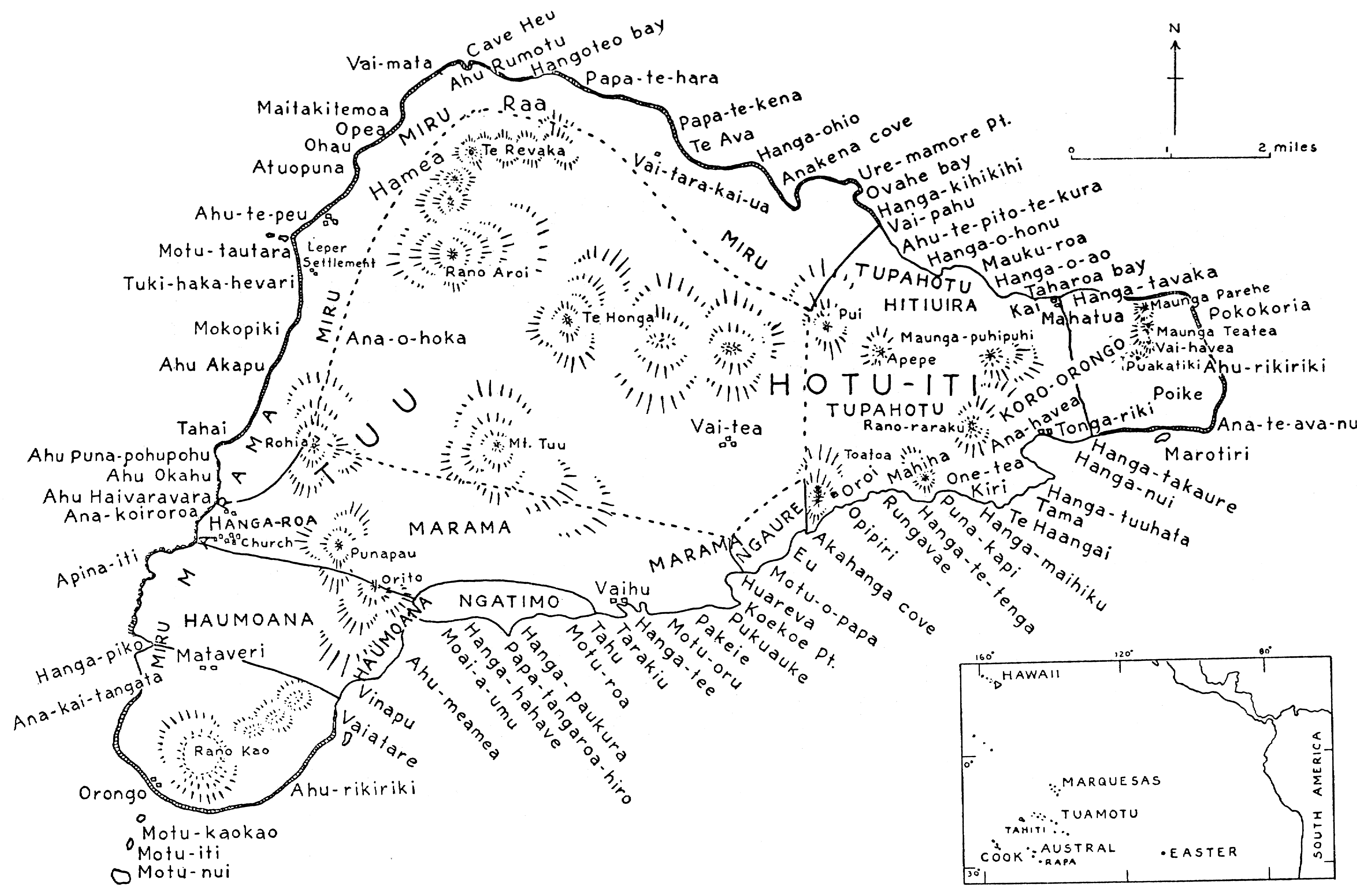
.jpg)
